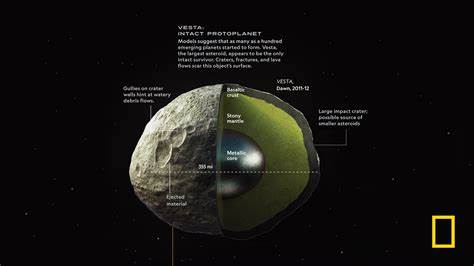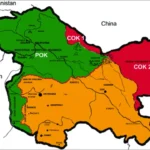May 22, 2025 | Space & Science News
In a groundbreaking revelation, astronomers now believe that Asteroid Vesta, one of the largest bodies in the asteroid belt, may be more than just a giant space rock — it could be the surviving core of an ancient planet that once orbited our Sun.
Recent data from NASA’s Dawn spacecraft and further analysis by international researchers suggest that Vesta’s unique structure, composition, and size set it apart from typical asteroids. Scientists now theorize that Vesta may represent the leftover remains of a protoplanet, an early building block of the solar system.
🌌 A Glimpse into the Early Solar System
Positioned between the orbits of Mars and Jupiter, Vesta measures approximately 525 kilometers (326 miles) across, ranking it as the second-largest body in the asteroid belt, just behind Ceres. What distinguishes Vesta is its differentiated structure — it has a crust, mantle, and metallic core, similar to that of Earth and other rocky planets.
According to Dr. Karen Ziegler, a planetary scientist at the University of New Mexico, “Vesta’s internal layering suggests it went through planetary formation processes but never completed its development into a full planet.”
🛰️ Dawn Mission Unlocks Vesta’s Secrets
NASA’s Dawn mission, which orbited Vesta from 2011 to 2012 before heading to Ceres, provided high-resolution imagery and gravity data that helped scientists model its internal composition. The findings revealed a metallic core surrounded by silicate rock — a feature uncommon in standard asteroids.
“These characteristics point to a planetesimal that was on the verge of becoming a full-fledged planet before solar system dynamics stunted its growth,” Dr. Marc Rayman, the chief engineer of the Dawn mission, explained.
🌍 Why Vesta Matters to Planetary Science
The new hypothesis elevates Vesta’s status from a large asteroid to a planetary relic, offering an unparalleled opportunity to study the early conditions of planet formation. Since Vesta never evolved into a planet, it has preserved its ancient makeup, serving as a time capsule from the solar system’s infancy.
Researchers believe that further study of Vesta could reveal insights into how rocky planets like Earth, Mars, and Venus formed.
“Vesta is like a fossil from the dawn of the solar system,” noted Dr. Ziegler. “It helps us understand what might have happened to other planetary embryos that didn’t make it.”
☄️ Vesta’s Violent History
Vesta’s surface is marked by massive impact craters, the most notable being Rheasilvia, a 500-kilometer-wide basin near the south pole, nearly as wide as Vesta itself. Scientists believe this ancient collision may have stripped away parts of its outer layers, leaving behind a more exposed planetary core.
These collisions also ejected fragments of Vesta into space, some of which eventually fell to Earth as HED meteorites (howardite, eucrite, and diogenite). These space rocks have helped confirm Vesta’s connection to planetary formation.
🔭 What’s Next for Vesta Research?
While the Dawn mission has ended, astronomers are pushing for future missions to return to Vesta — potentially with landers or sample-return missions. The European Space Agency (ESA) and NASA have discussed collaborative efforts to explore differentiated asteroids more thoroughly, and Vesta remains high on the target list.
In the meantime, Earth-based telescopes and spectrometers will continue to monitor Vesta’s orbit, surface changes, and thermal emissions.
📈 Vesta and the Broader Search for Planetary Origins
The revelation that Vesta could be the remnant of a failed planet provides crucial clues in the broader quest to understand the origins of our solar system. It suggests that multiple protoplanets may have formed and been destroyed or absorbed before the current configuration of planets took shape.
As scientists piece together this cosmic puzzle, Vesta stands out as a key witness to the chaotic and violent history of early planetary development.





